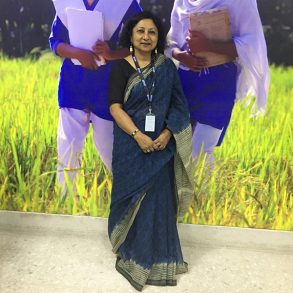Six skills critical to bridging the digital skills gap

In a digital age, it’s critical that populations have the skills to match. Today, those skills are unevenly shared between the genders. Here, Plan International and Telenor look into the reasons behind this divide, and six skills that could make the difference.
More than half the people on the planet use the internet, with more than 4.2 billion users logging onto the web in 2018. As digital platforms become more sophisticated, the demand for technically skilled workers increases. From programmers to data scientists, the opportunities to pursue lucrative, engaging careers grow all the time.
Yet these opportunities go disproportionately to men because of a persistent digital skills gap. Internet usage is 12% lower among women than it is among men, and that number more than doubles in some parts of the developing world. Despite the global ubiquity of mobile phones, 200 million more men than women own these devices.
These striking disparities underlie the digital skills gap and ensure that it will persist until women and girls are given equal access to technology as men. As International Women’s Day approaches, Telenor and their global partners, Plan International, are exploring the reasons behind the digital skills gap and how women can move closer to parity.
The Digital Skills Gap Runs Deep
A lack of access to the internet and mobile devices only hint at deeper problems. There are many reasons for the digital skills gap, including cultural perceptions that run deep — and which begin at early ages.

 “The digital skills gap persists because the discrimination starts early in life – at home – with the cell phone as the first point of contact with digital technology,” said Tania Nusrat Zaman, head of child rights and protection at Plan International Bangladesh. “Parents, particularly mothers, believe that daughters will use cell phones to communicate with boys and begin relationships that will lead to sexual encounters. The most ubiquitous, and cheapest, form of digital technology is therefore viewed negatively in the context of girls.”
“The digital skills gap persists because the discrimination starts early in life – at home – with the cell phone as the first point of contact with digital technology,” said Tania Nusrat Zaman, head of child rights and protection at Plan International Bangladesh. “Parents, particularly mothers, believe that daughters will use cell phones to communicate with boys and begin relationships that will lead to sexual encounters. The most ubiquitous, and cheapest, form of digital technology is therefore viewed negatively in the context of girls.”
The problem extends outside the home as well. Girls in Uttar Pradesh, India, receive fines of 2,100 rupees if they’re caught using mobile phones in public, a law that was purportedly designed to prevent these girls from eloping with young men. A third of men surveyed in Indonesia said they felt responsible for policing the content women consumed on the web.
 But even in the absence of fear-based, discriminatory policing, girls face challenges. Iris Caluag, Youth Employment Solutions (YES!) Program Officer at Plan International, said that in poor families, parents will prioritize their sons’ educations over their daughters. When girls do attend school, they may assume they’re not capable of studying tech-centric subjects and they’re less likely to pursue technical fields of study if they’ve never been exposed to them in supportive ways.
But even in the absence of fear-based, discriminatory policing, girls face challenges. Iris Caluag, Youth Employment Solutions (YES!) Program Officer at Plan International, said that in poor families, parents will prioritize their sons’ educations over their daughters. When girls do attend school, they may assume they’re not capable of studying tech-centric subjects and they’re less likely to pursue technical fields of study if they’ve never been exposed to them in supportive ways.
While cultural perceptions of gender and technology vary in different parts of the world, they’re not the only factors in exacerbating the digital skills gap. Even in societies that ostensibly attempt to offer gender neutral educations, women still fall behind when it comes to digital skills.
Swati Sharma, a product tribe leader at Telenor, said a lack of role models plays a significant role in the gender gap in developed countries. When women don’t see their peers entering unfamiliar career fields, such as programming, those areas remain opaque, she said.

It’s unclear what a programming course entails or what opportunities might be available in that area, and the lack of visibility into technical careers may cause women to avoid them. Those who are interested in technical careers will find few women on whom to model their own professional choices, and they may struggle to find mentors who can help them advance.
When young women and girls fail to see women in technical careers and leadership roles, they’re less likely to take an interest in those fields or to believe opportunities exist for them to do so.
“I think people who don’t work in technology overestimate the complexity,” Sharma said. She said there’s also a lack of understanding of what it means to work in technology. People often assume they’ll be sitting behind a computer in isolation all day, when in reality, they would be engaging with colleagues and with the clients and consumers for whom they are developing products.

Natalie Folge, head of Internet of Things (IoT) and Big Data at Telenor, emphasized the value of role models as well. She noted that the demographics of previously male-dominated fields, such as law and medicine, shifted as more women pursued careers in these areas and inspired other women to follow suit. Seeing women succeed in new areas sends a powerful message to girls and young adults still trying to discern their career interests.
Cultural Conflicts
Beyond biased education and employment policies, cultural and personal influences shape girls’ experiences as well. When it comes to nurturing an interest in technology among girls, Zaman says that it is the adults in their lives whose perceptions are skewed.

“Nothing from my years of consultations with young people, male and female, indicates that girls hold any common misconceptions about technology – which is a very positive sign,” Zaman said. “However, we do need to keep in mind that they do face a barrage of negative messaging starting with the family.”
The negative messaging continues in the lack of representation they see in technology. “What is often neglected is the fact that technology also reflects and actually reinforces predominant norms, attitudes and behaviors in (offline) society,” Caluag said. “In fact, in some instances, technologies have ended up recreating discriminatory patterns that developers either unconsciously introduced, or intended to avoid altogether.” The dearth of women in technology prevents companies from creating solutions that address problems for all users and perpetuates a lack of inclusivity in their product designs.
“Addressing the digital skills gap requires actions targeting the root causes of gender inequality, including challenging adverse norms, behaviors and attitudes that exclude girls and women from accessing and using technology in their personal and professional lives,” Caluag said.

The implications of the digital gap among young people extend beyond skills disparities and a lack of technical understanding. In Bangladesh, Zaman said young girls are naive when they do engage online, leading them into dangerous circumstances. A girl who has little understanding of the digital landscape is ill equipped to protect herself or feel she has any recourse when she encounters sexual harassment.
“Both girls and boys have shared stories about girls who make themselves vulnerable when online and later feel they have no recourse but to take their lives when threatened with release of private mail or photos,” Zaman said. However, teaching girls digital skills leads to a series of positive incomes, including increased self-confidence and exposing them to subjects that could lead to lucrative careers that further empower them.
Solving a Multi-Generational Problem
Addressing the digital skills gap will require efforts from multiple areas of society, including corporate initiatives to foster diversity and inclusiveness and schools introducing all children to opportunities to learn basic logic and engineering skills. Folge said exposing children to toys such as robotics kits and building projects that are marketed to both boys and girls can help female children become familiar with concepts that might interest them in technical skills.

Nora Lindstrom, global lead for digital development at Plan International, said that professional networks and mentorship initiatives are important for closing the digital gap. But, she added, tech companies also have a responsibility to proactively reduce inequalities.
“It’s important for tech companies to look inwards and make sure they are good places to work for women, where women feel supported and have opportunities to advance and develop their careers,” she said.
Fortunately, women don’t have to wait another generation before they begin closing the gap. Women today can take steps to improve their access to opportunities today and forge paths for young women who will follow them tomorrow. Cultivating the following skills will position women to claim their places in tech roles:
Computer literacy
Digital skills begin with computer literacy. Young women need to develop comfort and familiarity with computers, including word processing and database softwares as well anti-virus programs and internet norms, according to Zaman. Doing so demystifies computer and web programs and may help women feel more confident in learning more technical skills.

Familiarity and confidence with technology can lead not only to profitable careers, but deeply impactful ones as well. Mobile technology is being used in a number of areas to improve the lives of women and children globally. Case in point: Plan International Bangladesh’s initiative to reduce child marriages in Bangladesh by working with partner organizations to establish an SMS- age and identity verification system. When girls are not subjected to early marriage, they’re able to complete their educations and carve out healthy futures for themselves, rather than being forced to leave school early and potentially becoming victims of domestic abuse and violence.
Girls do not need to pursue advanced technological careers, but an understanding of different technologies and how they can apply to a range of scenarios will empower them to create groundbreaking solutions that could save lives and reduce inequities.
Programming
Programming is a highly lucrative career. Salaries vary in different markets, but to take the U.S. as an example, compensation ranges between $62,860 and $106,580. The good news is that even women who do not have access to a university-level education can learn programming skills via online courses that are either low-cost or free. Women may find government support as well, as is the case in Bangladesh.

Zaman noted a government program there that covers the costs associated with ICT training, including transportation expenses. Such initiatives help women overcome economic and educational barriers to develop competitive skills.
Lindstrom emphasized the value of basic programming skills and tech literacy as well. “Not everyone needs to be a master programmer, but it is vital that girls and women understand how technology works so that they can have a say in how technology developed and used, and what kinds of challenges are solved using technology,” she said. “We want girls and women to not just be consumers of technology, but also creators.”
Artificial Intelligence
Artificial intelligence (AI) refers to a broad category that includes subsets such as machine learning, deep learning, and natural language processing. These functions now appear in everything from smart home assistants to autonomous vehicles, and they become more ubiquitous every year. There is a strong demand for programmers who can build and work with AI programs.

“Everything related to AI and machine learning are super important if you want to be prepared for the labor market going forward, and also if you want to be part of the innovations that are happening in these areas over the next decade or so,” Folge said.
Women who are not inclined to become AI programmers would still be well-served by familiarizing themselves with the theory behind the technology and its implications in their fields. An understanding of AI will be critical as the tech is used more widely.
“If you think that AI sounds interesting but it sounds really complicated and you know it’s 99% men [who work in that field] and you will feel like the odd one out, then you will not think this is a fun area to work in and then you probably don’t pursue this as a subject at school,” Folge said. “But if you get things changing, then slowly it will be a more diverse workforce in this area, and then it will attract a lot of other women.
Maria Hycinth Umaran, PSM I, CBAP, who is the Product Owner of Plan International’s AI assistant in the Asia Regional Hub, echoed the importance of AI skills. “We are at its early stage but it is growing fast that it affects how we live, work and play,” she said. “Jobs will be created in development, programming, testing, support and maintenance.”
Virtual Reality
Virtual reality is becoming used more widely in fields such as entertainment and medical therapies, illustrating its value outside the gaming industry. Umaran noted the example of the Blue Room, a company that uses virtual reality to create immersive environments that therapists can use to help autistic children cope with their fears.

As in the case of the age verification platform in Bangladesh, an understanding of the technology can help women develop innovative strategies for helping and saving people’s lives. A woman working in virtual reality could become a programmer directly building the software, or she can serve the cause in another capacity, whether that is in business strategy, marketing, or consumer outreach.
Data Science
Data science professionals are increasingly in demand as companies attempt to not only capture as much information as possible about their customers and market, but to extract insights from it.

“In every industry now, we’ve collected tons of data which we really don’t know what to do with,” Sharma said. “I think we have matured quite a bit in data collection, but we have not matured as much in how to use the data.”
The ability to work with data positions women to engage in interesting and important work. Data is hugely important to improving human rights and creating new opportunities for underserved populations. Telenor partnered with UNICEF and government agencies in Pakistan to equip health workers with mobile devices that could be used to capture birth registration information. Unregistered children are more vulnerable to trafficking, early marriage, and exploitive labor schemes, and they are disadvantaged from social and health benefits, as well as other important services.
Digital Marketing
Digital marketing is hugely important to spreading information about innovative tech products and advances. Women who are interested in a particular area of tech but do not want to take on a technical career can develop careers as digital marketers in those fields. Engaging and converting users is highly important, particularly when companies and organizations are introducing new ideas to their target audiences.

Umaran noted that key digital marketing areas include SEO, content marketing, pay per click advertising, voice search, podcasting, video content, and conversion optimization. “The more connection with people, the higher number of lives influenced,” she said.
Women also position themselves for digital opportunities when they cultivate a suite of 21st century skills that apply across industries. Caluag suggested that women invest in their critical thinking, creative, and communication abilities, as well as their social acumen and tech and media literacy. These skills will prove pivotal to maintaining strong career potential as automation and AI drive massive change at every level. The World Economic Forum reported that critical thinking and interpersonal skills will be at a premium as automation and AI become more prevalent.
The Future Is Female If Women Claim It
The digital skills gap need not persist. As organizations and companies recognize the importance of mentorship and inclusivity, more women will be able to move into high-level tech positions and create paths for future generations. But more importantly, women have the ability to advocate for themselves and take control of their skill sets. By choosing to learn tech concepts, they will claim their seats at the table and close the digital skills gap one program at a time.
Explore more
Our commitment to SDG10, Reduced Inequalities